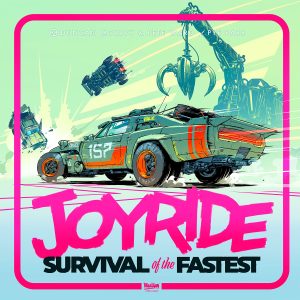 There are several themes that are used to the point of saturation in board games—trading in the Mediterranean, generic fantasy, nature, and post-apocalyptic car racing—to name a few. These themes are popular for various reasons, and they tend to work well. In the case of post-apocalyptic racing games, the Mad Max movies are probably the inspiration for this with the Road Warrior feeling like the inspiration for the original Thunder Road.
There are several themes that are used to the point of saturation in board games—trading in the Mediterranean, generic fantasy, nature, and post-apocalyptic car racing—to name a few. These themes are popular for various reasons, and they tend to work well. In the case of post-apocalyptic racing games, the Mad Max movies are probably the inspiration for this with the Road Warrior feeling like the inspiration for the original Thunder Road.
Today’s review is Joyride: Survival of the Fastest, a post-apocalyptic racing game that is a game for two to four players aged 10 and older.
Gameplay Overview:
To start the game, each player’s token is randomly placed on the initiative track starting at the bottom of the track. Then each player rolls and moves that far in a straight line. Those dice get moved onto their mirror for later.
- Start – It’s a phase for some driver abilities.
- Lock – Lock any dice on your mirror and then move that value shown.
- Shift – Change gears (or not) – which adds and subtracts dice as you shift up and down. You may opt downshift two spots and take a damage token.
- Roll – roll the remaining dice on your mirror and then move those values.
- End – Move all dice to your mirror, without re-rolling and assign damage tokens to any available slots. Adjust the initiative order with the highest gear player going earlier in the round.
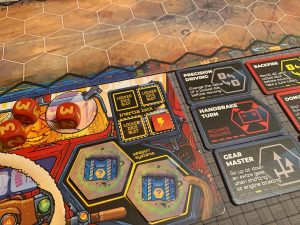
This is all fairly straight forward but there’s a catch: you can only make one steering move at the beginning of your movement. Twice if you’re in second gear.
Each car also has a choice of special moves with three being common between all the cars and three others being specialized to each car that allow you to do special actions, like steer twice, shift two gears, etc. These refresh at a rate of one per car ahead of you each lap so first place will have less of these advantages than the person in last place.
Additionally, at certain checkpoints, you gain items that generally make your opponent’s dislike you, unless your friends love slipping on oil slicks but who am I to judge? You can store up to two of these items before your inventory is full unless you’ve placed a damage token on one of those slots.
Races continue until the first car has completed the required number of laps.
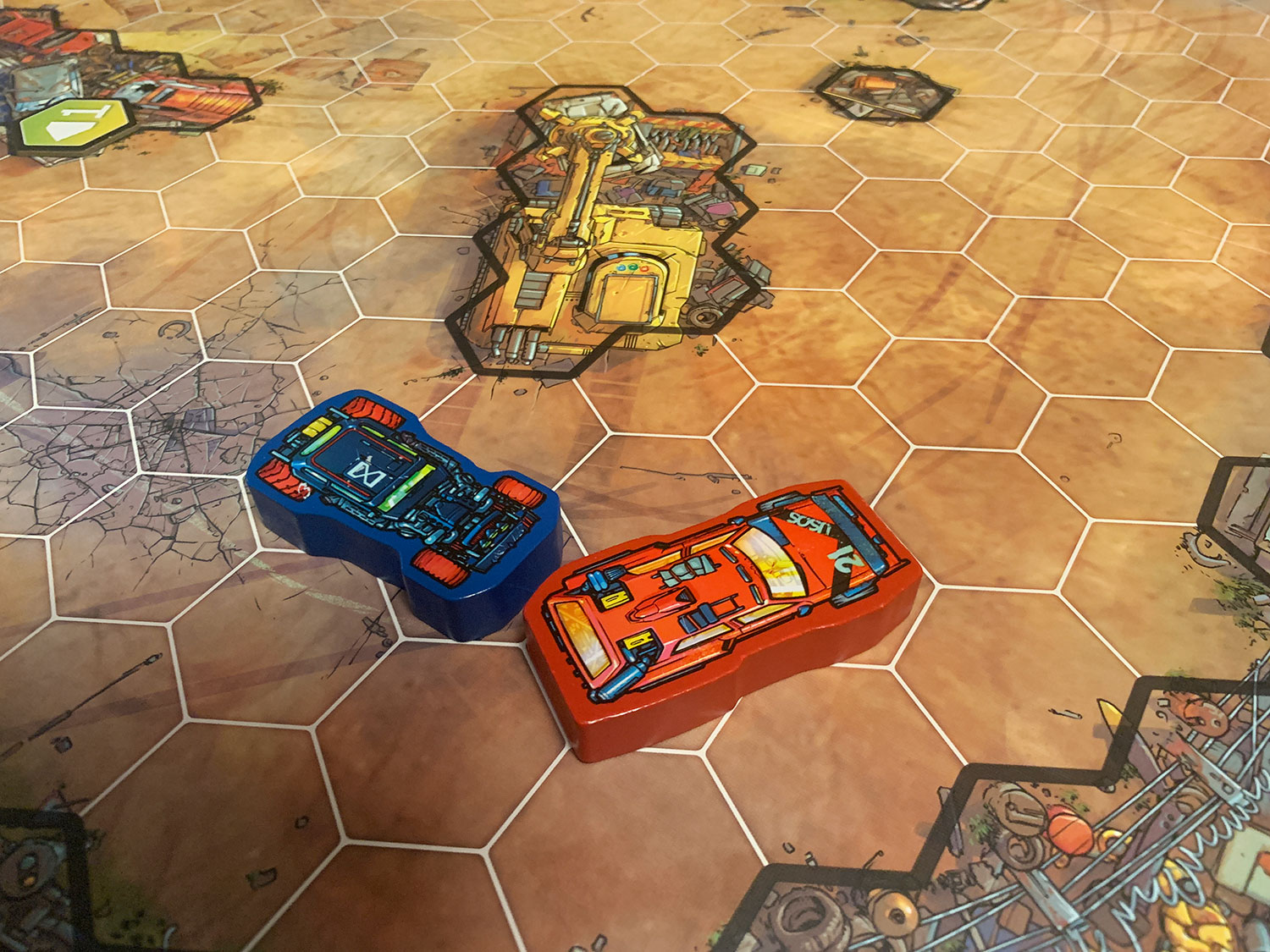
Game Experience:
Joyride is more of a race than Thunder Road Vendetta but also has more attacking other opponents than a game like Rallyman and genuinely feels like it’s drawn inspiration from both between being able to crash into and attack your opponents and the higher gears granting more dice for movement, respectively.
For me, what makes Thunder Road so much fun is the chaotic nature of the game with cascading crashing and unpredictable dice rolling. Joyride has some dice rolling but with dice rolling values of 1-3, there’s significantly less variance and sometimes I found that I’d just keep my pair of two’s and never re-roll them. Having to map out your moves so carefully makes this more a euro gamer’s fighty-racing game than a beer and pretzels game around a table that’s hootin’ and hollerin’.
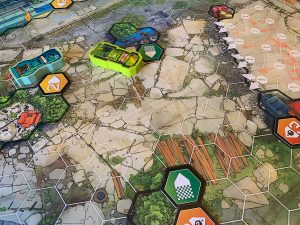
Because I could turn twice in Gear 2, I often found that I wanted to stay in Gear 2 or 3 most of the time, with the extra incentive of moving up the initiative track not being that appealing. Many of the races feature a lot of weaving through the course/obstacles. There’s one player ability that allows you to downshift twice but with it only being usable once per lap (assuming you’re not in first place and don’t get to refresh abilities), that’s still not a lot of flexibility.
However, these tight areas also lead to a lot of opportunities to smash into opponents, and the various mechanics around these are well thought out. If you side-swipe a car, you rotate it out of your way. Hitting from behind, reduces your remaining movement, while smashing a car into a barrier adds damage. These are both thematic and relatively intuitive to keep straight in your mind after a few games but it’s at the cost of a little extra rules overhead.
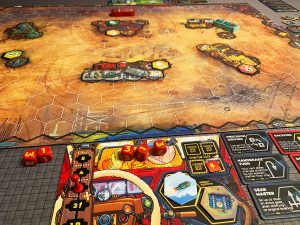
Taking damage, which covers various slots on your board, isn’t initially a game-ender. As I stated above, by rarely getting higher than third gear, the third and fourth dice locking slots were great places for damage as were fourth and fifth gear. Being able to choose where you assign it gives the players a lot of control but it’s at a cost of damage not being very impactful in the early parts of the race.
In two-player games, I felt like getting spun out, especially in shorter races, all but ensured that the car facing the wrong way was going to lose. In three and four player games, the chance of someone else doing the same thing gave me hope I could catch up, but I did sometimes find that once someone had a solid lead, they were going to run away with the race. Some of the special abilities can be helpful to get you back in the race, and practically are a little more friendly than launching rockets at your friends/opponents. But rubbing and rockets are racing, apparently.
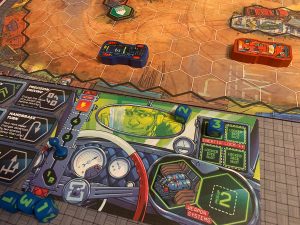
What took me out of the races faster than my poor driving decisions was the rulebooks. On the positive side I could, eventually, find what I needed and there are plenty of examples explaining many of the mechanics. But on the negative side, there’s no index, and using keywords is great but then I often found myself trying to find that word to understand the mechanic making the race feel like rush hour traffic as I looked up various keywords.
The rules are predominately in one booklet with the second explaining the cars in the set and the maps. The first page also nicely breaks down the suitable and ideal player count which shows that three players seems to be the best player count for the game and two players the least ideal.
Each car’s unique abilities do give players cars that will feel different and lend themselves to different strategies as their special abilities allow them to situationally bend the rules from time to time.
Lastly, the overall game production is good. I really like the big chunky wooden cars, and the artwork is pretty cool. I love how you have dice on your mirror (like fuzzy dice people used to hang from their mirrors) and the pawn marker being your gear shifts is fun (double-layered boards would’ve been tight!). And I like the fantastic yet practical look of the cars and dashboards in Pye Parr’s artwork.
Final Thoughts:
Joyride is a good game but I’m questioning where it fits between traditional racing (Rallyman GT and Thunder Rolls) and more destructive racing (Steampunk Rally Fusion, Thunder Road Vendetta, and Robo Rally) and, for my tastes, it’s kind of in the middle.
As I’ve been struggling with this conclusion, I’m finding the brain-burny nature is most like Steampunk Rally (though Joyride’s mental load is lower) which, I also noted was a game kind of living in the wasteland between Euro and Ameritrash. And that makes it harder to pinpoint the target audience for Joyride. Basically, if you roll your eyes more than the dice at Thunder Road but still want to inflict some damage during a race, Joyride may be a game for you.
Final Score: 3 Stars – Joyride splits the difference between thinky and chaotic, traditional racing and demolition derby, making it a very deliberate racing experience with a dash of destruction.
 Hits:
Hits:
• Overall production is fun without going overboard
• Variable player powers make each car different
• Locking dice reduces randomness and gives a lot of control over movement
• Rulebook is full of examples
Misses:
• Turns can grind to a halt while people math out their moves in slow motion
• Runaway leader problems
• Rulebook, while detailed, needed an index
• Felt like I needed to drive in second gear most of the time
Source: Board Game Quest



